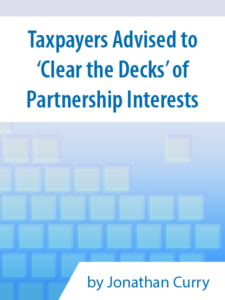Taxpayers with questionable limited partnership interests that might ultimately trigger unwanted inclusion in an estate may want to take advantage of the doubled estate tax exemption now to save themselves trouble later.

A string of opaque court cases has yet to provide bright lines on when a limited partnership interest is enough to cause inclusion in an estate under section 2036, but some taxpayers can avoid the question altogether by gifting those interests if they have unused exemption.
In the 2003 case Estate of Strangi v. Commissioner, T.C. Memo. 2003-145, the Tax Court made clear that a general partnership interest was enough to cause inclusion in an estate. But more recently, Estate of Powell v. Commissioner, 148 T.C. 18 (2017), and Estate of Cahill v. Commissioner, T.C. Memo. 2018-84, opened the door to the idea that a limited partnership interest was sufficient on its own.
N. Todd Angkatavanich of EY noted that estates that have been victorious in section 2036 challenges have succeeded through use of the bona fide sale exception, in which the reason for putting assets in a partnership has a legitimate nontax purpose. Unfortunately, he added, there’s no bright line for what constitutes a sale, and it doesn’t get tested until the taxpayer is under audit.
“The practical takeaway on the evolution of these cases and what it means for your [family limited partnerships] . . . is it’s so important to go back, take a look at your arrangements, stress-test it, take a look at what’s in the record as far as satisfying the bona fide sale exception — how good a narrative do you have?” Angkatavanich said.
Proactive Planning
After a taxpayer’s interests in an FLP have been evaluated, “think about what you might be able to do to fortify it, or maybe even clear the decks, particularly as we have this increased gift tax exemption,” Angkatavanich continued.
If the situation is ambiguous, like if a parent still owns 40 percent of a limited partnership interest or has a general partnership interest stemming from a time when the estate and gift tax exemption was lower, the taxpayers could consider paying off promissory notes, Angkatavanich said. If a taxpayer has additional limited partnership units remaining, they could also consider making gifts of those, he said.
If it’s a large partnership beyond the scope of any unused estate and gift tax exemption, the taxpayers could consider unwinding the partnership altogether, although that could entail significant tax consequences, according to Angkatavanich.
“You could be running away from one trap, and you don’t want to be running into another one,” he said.
Angkatavanich warned that even if a taxpayer manages to get rid of the interest, “you’re still going to potentially be subject to a three-year pullback under section 2035.” However, he noted that “it’s still better to get that clock ticking than not.”
Angkatavanich also cautioned against “offensively try[ing] to cause inclusion in the estate” by attempting to “manufacture bad facts” that would definitely cause inclusion under the logic of Powell and Cahill and result in a basis step- up on those partnership interests.
“Proceed with caution!” Angkatavanich said. “You don’t want to do that and then all of a sudden find that the estate tax exemption goes down” if Democrats take control in the 2020 election and reform the estate tax before the taxpayer dies, he said.
Loomis-Price further cautioned that section 2036 deals with subjective intent at the time a limited partnership was created, and a taxpayer is unlikely to be able to “artificially manufacture” inclusion under section 2036. “I think the IRS would have a good argument [section] 2036 doesn’t apply because that wasn’t your intent at time of creation,” she said.
Steve Gorin of Thompson Coburn LLP added that for a taxpayer to argue that the substance is different from the form, the IRS would require clear and convincing evidence. “All the IRS has to say is you haven’t presented clear and convincing evidence, and that’s a lot stronger than just a preponderance of evidence,” he said.
Watch Your Language
Given the IRS’s close scrutiny of FLP arrangements, both Loomis-Price and Gorin suggested that practitioners be careful in how they brand them to prospective clients.
“If you use the term FLP, what you’ve done is you’ve added an ‘F’ at the beginning, and that ‘F’ describes what the IRS and the courts are gonna do to you when you have something like this,” Gorin said.
“Please, just avoid the F-word!” he pleaded.
Loomis-Price likewise said that when she sees presentation materials describing an FLP, she considers it “bad lawyer marketing” because the IRS will pick up on it and use it against the taxpayer. “They are limited partnerships. They are not necessarily family, because that implies all sorts of weaknesses that the IRS is going to try to take advantage of,” Loomis-Price said.
This article was written by Jonathan Curry and originally published by Tax Notes. To learn more about the author and Tax Notes, please visit taxnotes.com.
